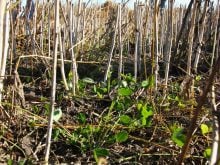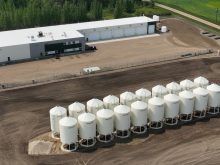SPRINGFIELD, Illinois — The new Wintex 1000 Automatic uses a computer controlled probe to repeatedly hit the exact same depth for each soil sample.
Built in Denmark and marketed by Precision Technologies in Iowa, the Wintex made its North American debut at InfoAg here last month.
One big factor in sparking the plethora of new soil sampling machines on the market is stricter regulation regarding manure on fields, says Wintex rep Bryan Arndorfer.
“But there’s more to it than that,” adds Arndorfer.
Read Also

Using artificial intelligence in agriculture starts with the right data
Good data is critical as the agriculture sector increasingly adopts new AI technology to drive efficiency, sustainability and trust across all levels of the value chain.
“As soil sampling becomes easier and guys become more familiar with it, they’re looking to use it for better productivity from their fields and better efficiency from their cash inputs.”
He says the Wintex 1000 was designed not merely to meet the demand for more machines in the field. It was designed specifically to meet the demand for better quality machines that create a more accurate soil sample.
“For example, if you take a sample with a conventional auger, you always end up with more material from the top layer than the lower layers. That’s not a quality sample,” says Arndorfer.
“Unlike the auger, a probe takes a sample that accurately represents the soil layers from top to bottom. It’s like the traditional hand probe, only mechanized so it’s way faster.”
The hydraulically driven drilling head rotates the probe as it penetrates the soil.
This provides a more representative core in sandy, wet, compacted or mucky soils.
The ejector rod’s outer diameter is the same as the probe’s inner diameter for a complete clean out. This ensures that previous cores don’t contaminate the next core.
The Wintex probe takes samples from four inches to 12 inches, with repeatable depth accuracy controlled by a computer. A sensor automatically stops the stroke if it hits a rock.
If the probe is damaged in the field, a threaded collar allows the operator to remove the old probe and install the replacement.
Depending on how the computer is programmed, the machine automatically pulls 12 to 15 cores totalling about one pound of soil to create a single sample. This is the quantity of soil per sample preferred by most soil labs.
The Wintex 1000 has the capacity to bag 38 soil samples per hour with 12 probes in each sample. That works out to about 450 probes per hour.
“And the entire function is computer controlled, so it’s quick. There’s not a wasted second when you’re in the field.
“We have a two to three second cycle time per core. It’s less than one minute to take a complete 10 or 12 core sample and bag it. Then you drive to the next spot.
“ And there’s no guesswork by the operator. He knows that the probe goes down to the precise prescribed depth every time.”
The operator remains on the quad throughout the process.
For safety purposes, the unit employs a series of switches that force the operator to keep hands and feet clear of the tower while drilling.
If the unit is equipped with GPS mapping and autosteer, the only thing the operator needs to do is dump the samples into the bag.
The Wintex probe and soil transfer system is hydraulically driven. On smaller quads, Wintex recommends an auxiliary five horsepower Honda to run the hydraulics.
On larger quads, Wintex supplies a hydraulic pump that is driven by the quad engine.
“It’s nice to have the pump on the quad. It’s quieter and it leaves you more space on the racks. But you need at least a 650 cc or 750 cc quad, and it should be a twin so you have enough low-end torque for the pump.”
The Wintex 1000 with a five h.p. Honda lists for $7,695 and should fit any quad on the market.
The Wintex 1000 with the hydraulic pump integrated into the quad engine lists for $8,295.
Contact Precision Technologies at 515-885-0330 or visit www.wintex1000.com.















